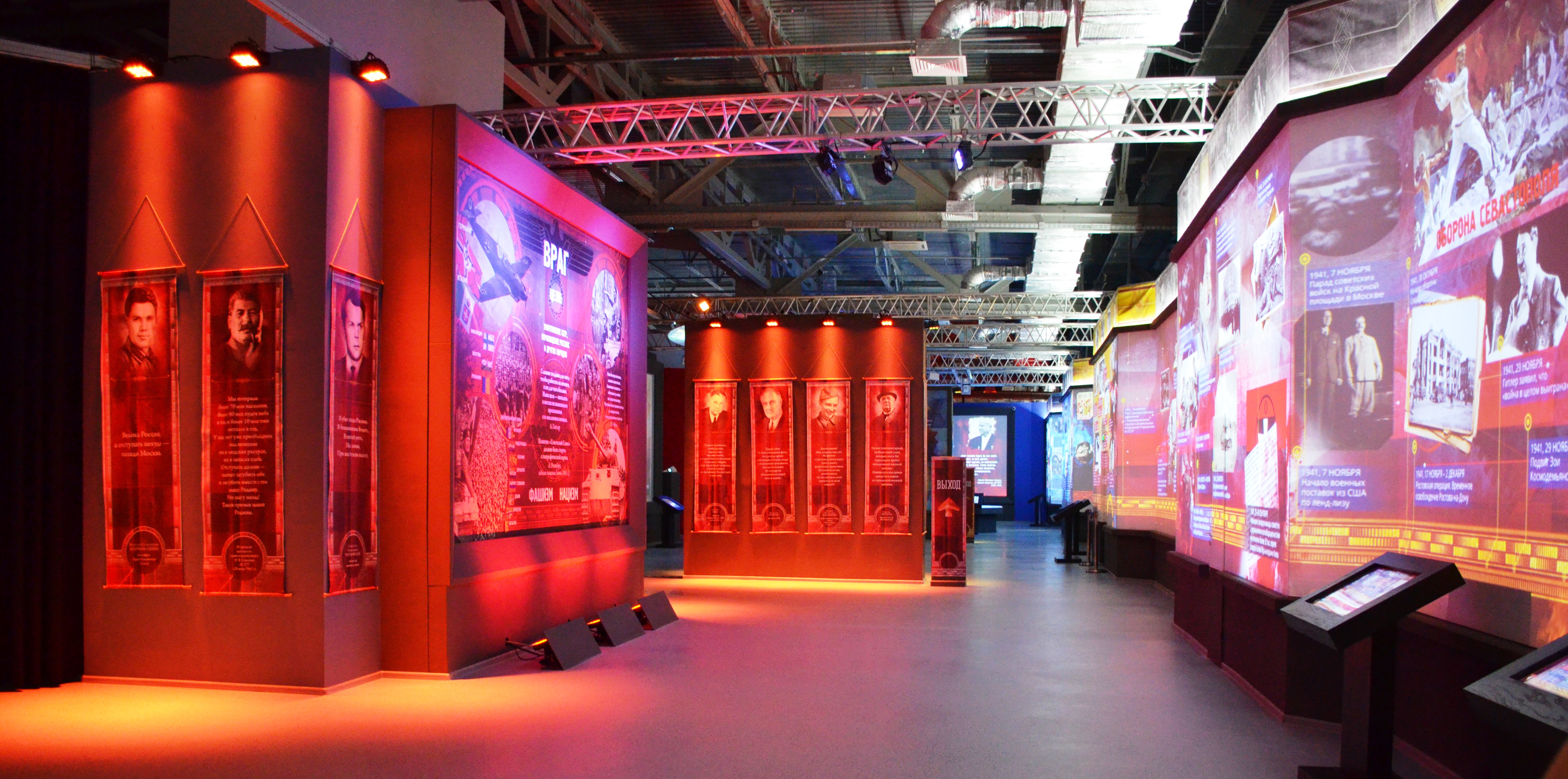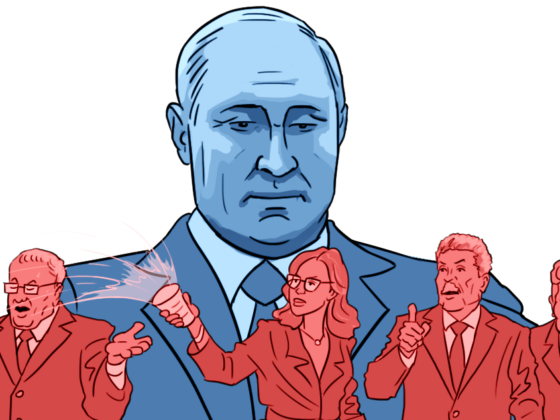
► Moscow’s VDNKh tradeshow and amusement park has been hosting “Russia, My History,” an enormous historical exhibit that deploys the latest interactive technologies in the service of the Russian Orthodox Church’s historical narrative.
At the forefront of the megaproject is the Patriarchate Council for Culture, an organ of the Church created in 2010 on the initiative of Father Tikhon, Putin’s purported confessor, who spearheads the Church’s ideological activism and penetration of state institutions. The idea of an historical park was also supported by the Moscow municipality—which has been very close to the Church since the leadership of former mayor Yuri Luzhkov—and was partly funded by big firms such as Norilsk Nickel and several subsidiaries of Gazprom. It has also received support from the Presidential Administration: Vladimir Putin, Dmitri Medvedev, and then-deputy prime minister Vyacheslav Volodin met with Father Tikhon and other orchestrators of the project on several occasions. The pavilion hosting the exhibition was renovated for 1.4 billion rubles, all drawn from the federal budget.
|
“The success of the project lies in its unique combination of a conservative reading of Russian history with an ultra-modern medium for its transmission.” |
The historical park is promoted as a “living textbook.” Visitors travel through three exhibition halls, devoted to the Ryurikids, Russia’s first dynasty, the Romanovs, and Soviet history, respectively. The park designers took their inspiration from multimedia technologies, combining many visual elements—photos, videos, and animations—with infographics and short texts. The exhibitions thus aim to produce not a research-based product, like a conventional museum, but a more popular outcome designed to reach larger audiences. The park’s reach is still unclear, but it seems to be primarily targeting schoolchildren, with the goal of shaping the youngest citizens’ views of national history. The success of the project lies in its unique combination of a conservative reading of Russian history with an ultra-modern medium for its transmission.
The Ryurikid exhibition celebrates an ancient Russia shaped by its Viking past (with obvious Aryan connotations), the embrace of Christianity, and several epic battles, all represented by animations obviously inspired by video game culture. The Ryurikid and Romanov sections use similar color codes: events that were positive for Russia appear in green, while those that were negative for the country are displayed in red. Each historical period, reign, or event is therefore colored either green or red, with an infographic to explain if Russia expanded or retracted territorially and if its population increased or decreased. The exhibit advances a classic vision of Russia as an empire: what is good for Russia seems to be defined in terms of size and power. Both exhibitions offer a running dialogue between the past and the present, mostly through a selection of quotes from the most famous Russian historians and intellectuals, as well as from Putin, Lavrov, and other political figures, thus helping the audience re-interpret the past in light of current events.
The Romanov section, the most ideological of the three, takes an openly monarchist stance, systematically presenting the Russian tsars as wise heads of state. Any attempt to question their autocratic power is condemned as a plot concocted by Russia’s enemies, external and internal. Revolutionary movements, including the Decembrists, are depicted (in red) as a masonic-inspired conspiracy. The huge area devoted to the 1914–1917 period, which occupies several rooms, is particularly visually powerful. Three documentary films propagate the Church’s reading of 1917, which can be summarized as follows: under Nicholas II, the Russian empire was on the way to a flourishing and modernizing future—economically, politically, and culturally—when it was destroyed by a combination of external and internal forces. The seeds of evil were sown with the Revolution of 1905 and the transformation of the autocracy into a parliamentary democracy.
One film denounces for instance the “weakening of state censorship that allowed liberals to de-sacralize the Tsar.” The First World War is presented as a huge geopolitical game to reshape Europe’s map by destroying the Habsburg, Ottoman, and Romanov empires. The February revolution was prepared with the help of “foreign and domestic capital,” with a specific focus not, as might have been expected, on Germany, but on Great Britain. Another documentary on the 1917 coup places the blame on the liberals: “The treason and defection of the high military and Duma leaders resulted not only in defeat during the war but in the total collapse of the empire.” This makes the February revolution the first “color revolution” in Russia’s history, claims another of the films, which draws overt parallels with the Orange revolution, the Euromaidan, and the Arab Spring. It declares: “The Romanov throne collapsed due not to the coup carried out by Soviet and terrorist-revolutionaries, but the one by aristocratic families, court nobles, bankers, publishers, lawyers, professors, and civil society organizations.”
|
“It also confirms the presentism of the Church’s historical policy: today’s identified ideological enemy is liberalism, not communism or even Soviet nostalgia.” |
By stating that the “Russian empire was destroyed by its own elites,” the Church frames the February revolution—which symbolizes liberal values and Western-oriented worldviews—as the real evil that destroyed Russia. Bolshevism arrives only later, as a consequence of the failure of liberalism. If Lenin is presented as a puppet in the hands of Germany, his role becomes almost secondary; his team is framed as a group of weak revolutionaries with little popular support. It is therefore not Soviet Russia but the West that is responsible for the fall of Tsarism. This ideological “trick” allows the exhibition to avoid being too confrontational toward the state-sponsored valorization of the Soviet Union. It also confirms the presentism of the Church’s historical policy: today’s identified ideological enemy is liberalism, not communism or even Soviet nostalgia.
The Soviet Union section of the historical park offers a more complex discursive line that has to take into consideration the gap between the Church narrative and that of the state. While the Bolshevik revolution and the civil war are presented as negative moments (colored in red), the positive (green) aspect reappears quite early on, with the creation of the Soviet Union in December 1922. As soon as the state is re-established and the territory secured, the Soviet regime gains legitimacy. Another color—blue—is then introduced to the exhibition’s “visual doctrine” to describe the cultural, scientific, and technological achievements of Soviet Russia and everything related to the notion of progress. In this way, the exhibition moves away from the dichotomy between green and red that characterizes the previous sections toward a more consensual and “mainstream” reading of the Soviet past.
|
“It is therefore not Soviet Russia but the West that is responsible for the fall of Tsarism.” |
The Bolshevik “mocking” of “Russian national traditions,” the regime’s atheist ideology, and the persecutions of the Church in the 1920s and 1930s are heavily condemned in several rooms. Yet Stalinism is also plainly rehabilitated as the return to national values, to “the traditional-for-Russia line of a strong and autonomous state,” and is praised for restoring to their proper place Russian heroes and symbols that the Bolsheviks had desacralized. As another documentary boldly states, “already at the end of the first industrialization plan, the Soviet Union resembled more a new Red Empire than an Internationalist utopia.”
The exhibition has been a success, both politically and commercially. In a sign of the Church’s effective lobbying strategy, at the end of 2016, the Ministry of Education and Science recommended for schools to visit the exhibition as part of history classes, then recommended that students in higher education institutions and future history teachers studying in pedagogical institutes also go. The state agency for tourism, Rosturism, plans to include the exhibition in its program for tourist groups.
By the end of 2017, nine replicas of the Moscow exhibition park had opened (in Ufa, Stavropol, Yakutsk, Makhachkala, Kazan, Tyumen, etc.) and more than 15 others are planned. All exhibitions have received financial support from their respective regional and municipal budgets, and several have been awarded grants from the Presidential Administration. Regional parks are allowed to introduce local components to the exhibition in order to better reflect the specificities of local history.
The Moscow Patriarchate has thus succeeded in promoting a narrative that partially goes against the state’s historical policy in its reading of the tsarist and Soviet past while simultaneously benefiting from state support—an illustrative example of the plurality of voices on national history accepted by the Russian authorities.
Marlene Laruelle is Associate Director and Research Professor at the Institute for European, Russian, and Eurasian Studies (IERES), Elliott School of International Affairs, The George Washington University, Washington, DC. Dr. Laruelle is also a Co-Director of PONARS Eurasia (Program on New Approaches to Research and Security in Eurasia).
Image credits: Marlene Laruelle












